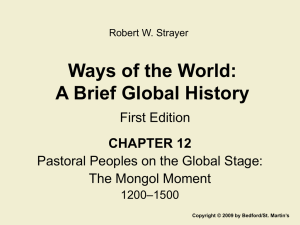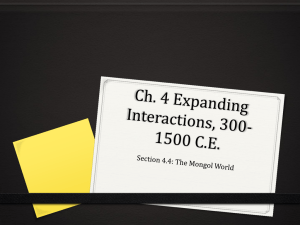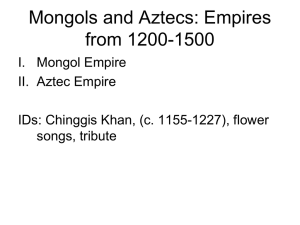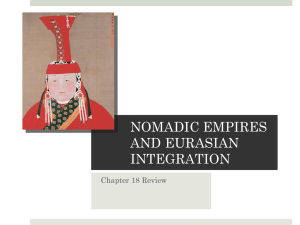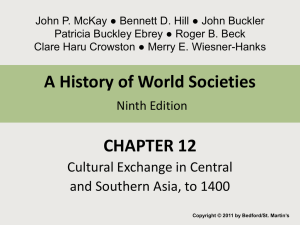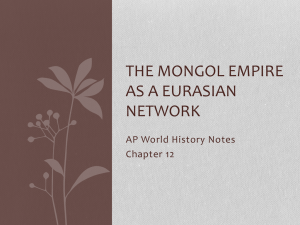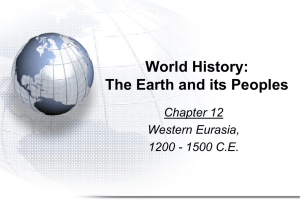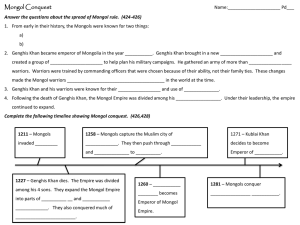Chapter 14: The Last Great Nomadic Challenges: From Chinggis
advertisement
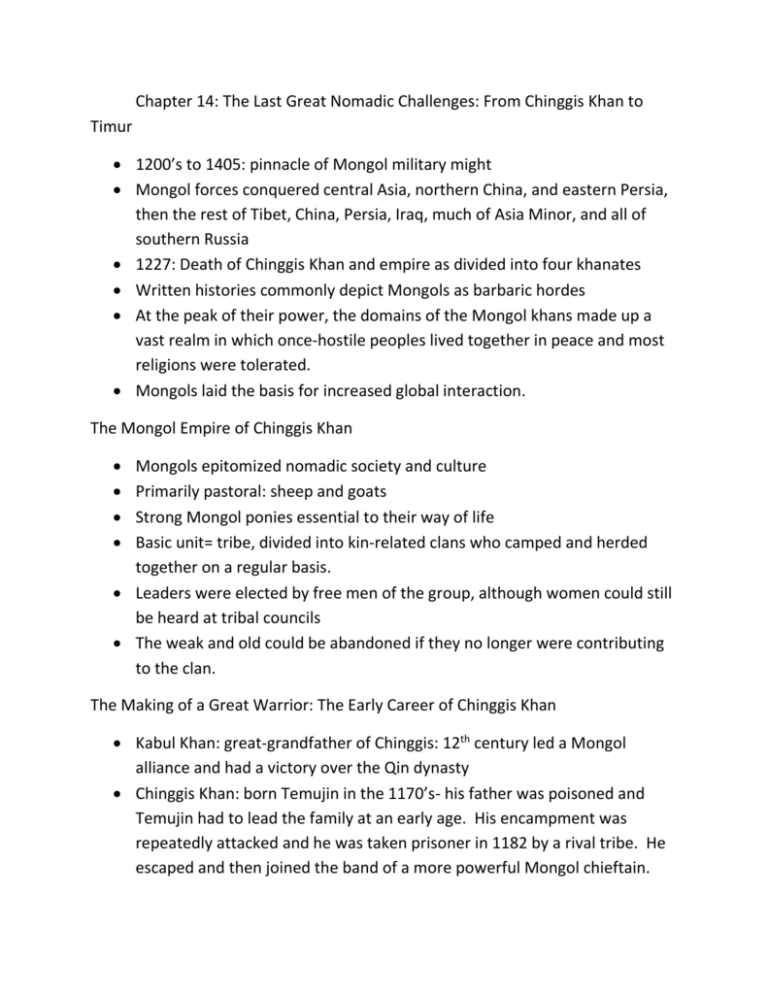
Chapter 14: The Last Great Nomadic Challenges: From Chinggis Khan to Timur 1200’s to 1405: pinnacle of Mongol military might Mongol forces conquered central Asia, northern China, and eastern Persia, then the rest of Tibet, China, Persia, Iraq, much of Asia Minor, and all of southern Russia 1227: Death of Chinggis Khan and empire as divided into four khanates Written histories commonly depict Mongols as barbaric hordes At the peak of their power, the domains of the Mongol khans made up a vast realm in which once-hostile peoples lived together in peace and most religions were tolerated. Mongols laid the basis for increased global interaction. The Mongol Empire of Chinggis Khan Mongols epitomized nomadic society and culture Primarily pastoral: sheep and goats Strong Mongol ponies essential to their way of life Basic unit= tribe, divided into kin-related clans who camped and herded together on a regular basis. Leaders were elected by free men of the group, although women could still be heard at tribal councils The weak and old could be abandoned if they no longer were contributing to the clan. The Making of a Great Warrior: The Early Career of Chinggis Khan Kabul Khan: great-grandfather of Chinggis: 12th century led a Mongol alliance and had a victory over the Qin dynasty Chinggis Khan: born Temujin in the 1170’s- his father was poisoned and Temujin had to lead the family at an early age. His encampment was repeatedly attacked and he was taken prisoner in 1182 by a rival tribe. He escaped and then joined the band of a more powerful Mongol chieftain. 1206 at a kuriltai (meeting of all of the Mongol chieftains), Temujin was elected the Khagan, supreme ruler, of the Mongol tribes. Building the Mongol War Machine Preferred weapon of Mongol warriors was their short-bow Mongol armies were entirely cavalry so they could move rapidly Loyalty to Chinggis overshadowed previous vendettas and quarrels Tumens: Basic Mongol fighting units made up of 10,000 warriors. Each was further divided into units of 1000, 100, and 10 warriors. Commanders were responsible for training, arming, and disciplining the cavalrymen under their charge. Divided into heavy and light cavalry Separate messenger force for communication Strict and summary justice for deserters (execution) Cartography improved, extensive spy network. New weapons: flaming and exploding arrows, gunpowder projectiles, and later bronze cannons. Conquest: The Mongol Empire Under Chinggis Khan Chinggis Khan once said his greatest pleasure in life was making war, defeating enemies, forcing “their beloved to weep, riding on their horses, embracing their wives and daughters.” Attacked the Xia Xia kingdom in northwest China, then the Qin Empire. Siege weapons were key: including fiery goo made with Dolphin bladder. Mongols usually spared famous scholars and artisans b/c they were useful, but resisting townspeople were slaughtered or sold into slavery. Surrendering towns were usually spared but had to pay hefty tribute. First Assault on the Islamic World: Conquest in China 1219: Chinggis Khan annexed Kara Khitai Muhammad Shah II- Turkic ruler of the Khwarazm Empire to the West Muhammad Shah II: Assaulted Chinggis’ envoys (Don’t shoot the messenger): led to war Use of cavalry, feigned retreat and mass attack Life Under the Mongol Imperium Chinggis was illiterate Chinggis established a capital at Karakorum o On the steppes Gathered information from artisans, Confucian scholars, and Daoist holymen Religion: Shamanistic (focused on nature spirits) Administration developed Record-keeping: standardization of laws The Death of Chinggis Khan and the Division of the Empire Chinggis ordered that the Tangut civilization be wiped off the face of the earth. Chinggis died in August 1227 Chinggis’ body returned to Mongolia- humans and animals were killed that crossed its path on journey Empire divided between 3 sons and 1 grandson (Batu) Kuriltai at Karakorum: Ogedei (3rd son) elected Grand Khan: further campaigns and conquests The Mongol Drive to the West Mongol raids into Georgia and across Russian Steppe Christian lands were ripe for the taking Golden Horde: nickname of the Mongols Batu, Grandson of Chinggis- began invasion of Russia in 1236 Russia was lacking solidarity to resist the Mongols 1236: Batu: 120,000 cavalrymen into Russia Tatars/ Tartars (people from hell): nickname for the Mongols Mongols had a successful winter invasion of Russia 2nd Mongol invasion in 1240: Kiev fell Prince Alexander Nevskii submitted to Mongol demands Russia in Bondage Russian princes as vassals of khan of Golden Horde and paid tribute Led to feudalism/ serfdom for some Some peasants fled to remote areas City of Moscow grew in strength as tribute collectors for Mongols Moscow: center of Orthodox Church “3rd Rome” Moscow eventually organized a force that defeated the Golden Horde at the Battle of Kulikora Russia because of Mongol rule, was isolated from Europe and the Renaissance and Reformation there. Mongol Incursions and the Retreat from Europe Prester John: mythical rich and powerful Christian monarch, some said in Africa or Asia, whose kingdom had been cut off from Europe during Muslim Expansion. Forces would eventually strike Muslims from rear and reunite with Europe according to this legend Some Europeans thought Chinngis was Prester John But then the Mongols attacked Russia (orthodox) proving they were in fact a threat to Christendom King Bela of Hungary: dismissed Mongol envoys and refused to submit to Mongols Only thing that stopped Mongol raid of rest of Western Europe was the death of Ogedei, so Batu had to retreat to prepare to struggle for succession The Mongol Assault on the Islamic Heartland Hulegu, grandson of Chinggis and ruler of Ilkhan portions of Mongol Empire who worked to conquer Muslim empires of Mesopotamia and north Africa 1258 Baghdad was captured and destroyed Last Abbasid caliph and 800,000 were killed 1260 Mongols were defeated by the Mamluk, slave dynasty of Egypt, led by Baibars Christians cooperated with Baibars against the Mongols Berke: khan of Golden Horde, Muslim, challenged Herlegu’s authority The Mongol Interlude in Chinese History Mongol rule in China lasted about 100 Years Mongols retained a distinct culture and social separateness until they were driven back beyond the Great Wall in late 1360’s Helped open up China to foreign contacts with Arabia, Persia, Europe Kubilai Khan: grandson of Chinggis led campaigns against Song 1260 Kubilai became Great Khan 1271 established the Yuan dynasty in China Kubilai tried to preserve the distinction between Mongol and Chinese Chinese scholars forbidden from learning Mongol script Mongols forbidden from marrying ethnic Chinese Kubilai did surround himself with Chinese advisors: Buddhist, Daoist, and Confucian Capital @Tatu (Beijing) New social structure: Mongols on top w/ central Asian nomadic and Muslim allies below them on hierarchy- then north Chinese and then ethnic Chinese Gender Roles and the Convergence of Mongol and Chinese Culture Mongol women refused to footbind Women hunted with their husbands Chabu: wife of Kubilai Khan: close advisor promoted Buddhism Mongol Tolerance and Foreign Cultural Influence Patronage of scholars, artists, artisans, and office seekers to Yuan court. Mulsims played important role Chinese style imperial city with Muslim architects o Tax collections, navigation, cartography Kubilai welcomed visitors: including Marco Polo and family. o 17 years: allegedly resided at Kubilai’s Court famous account o Increased European interest in Asia Social Policies and Scholar Gentry Resistance Ethnic Chinese never reconciled to Mongol rule Kubilai refused to reinstate civil-service exam- alienate scholar-gentry Kukbilai encouraged artisan class and merchants (against Confucianism) Mongols developed substantial navy o Failed attacks on Japan (Divine Wind: Kamikaze) Literary work: Yuan period: The Romance of the West Chamber Protected peasant class: granary system for famine relief Proposed elementary education programs in villages The Fall of the House of Yuan Mongol rule lasted 90 years: Kubilai majority of that time Song protest Failure of military expeditions against Japan in 1274 and 1280 Scholar-gentry capitalized on discontent White-Lotus Society: secret organization dedicated to overthrowing Yuan Dynasty. o Claim of magical powers Ju Yuanghang: poor peasant emerged to forge the Ming Dynasty Aftershock: The Brief Ride of Timur Timur-I Lang (Timur the Lame/ Tamerlane) Turk noble who led a nomadic attack Troops committed great atrocities Traveled with skulls of victims Capital at Samarkand Spared artisans and scientists to improve their capital Timur died I 1405 and empire fell apart Genetic Links today to Genghis Khan: Common ancestor in genome code. Old Book Tamerlane (b.1330’s-d.1405) (Timur the Lame) ruler of Mongol Khanate based in Samarkand (former Mongol Empire) large conquest campaign End of 15th c. new threats: Mughals and Portuguese traders
